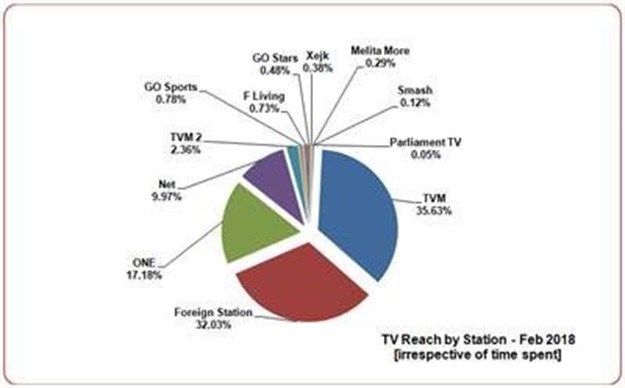
Top stories


Marketing & MediaCammy Msimango on finding her footing in South Africa’s fast-moving digital newsroom
Esther Tomorrow, MDNTV 22 hours




More news



Following the introduction of the Broadcasting Act in 1991 and the liberalisation of the airwaves, the proliferation of radio and TV stations has been quite remarkable according to Dr Pierre Cassar, director: Marketing, Communications and Alumni Relations for the University of Malta and the former CEO of the Broadcasting Authority.
Malta completed its digital switch over in 2012. The national broadcaster operates two stations: TVM and TVM2. The former is the most popular station with around 33% market share. The ruling Labour Party operates One TV while the opposition Nationalist Party owns Net TV, both channels being overtly skewed towards their party lines. F Living Channel, Smash TV and Xejk are three privately owned channels and they are more or less impartial in their output. In addition to these, we also enjoy Parliament TV which is a station dedicated exclusively to parliamentary proceedings (which come to us from the Renzo Piano-designed chambers which have earned the contemporary building structure the somewhat denigrating nickname of the cheesegrater). There are also two teleshopping channels broadcasting exclusively on the Melita Network.
In the Broadcasting Authority’s Feb survey, respondents were asked what type of programme they like to watch on Maltese television stations. Local and foreign news were the favourite programme genre (27.2%); followed by local drama (17.3%); and discussion and current affairs programmes (12.6%). Analysed by gender, male preferences greatly exceeded female preferences for sports programmes (M: 29.7%; F:7.8%), while female preferences greatly exceeded male preferences for drama (F: 54.9%; M:33.5%).
The most common service to watch television is that of a paid subscription (66.0%) followed by internet based services (10.8%). 4.6% of the population follow television on the free-to-air platform. Of this group, 62.6% (or 12,100) have an only free-to-air connection while the rest (37.4%; 7,300) make use of one or more of the other services available.
264,000 persons (aged 12 years and over) follow television regularly. This is about two-thirds of the population (63.3%). Compared to previous data, there was a decrease of 1.4% of viewers over the previous assessment period of October 2017 and a decrease of 5.0% over that of the same period last year.
TVM attracted the largest amount of TV-viewers (35.63%); followed by One (17.18%), Net TV (9.97%), and TVM2 (2.36%). Beside these, 32.03% of the population followed a foreign TV station. On average TV viewers spent about 1.81hrs every day watching their favourite programme.

Having acquired a Smart TV last month, we are still navigating our way through over 4,000 channels (actually we rarely bestir ourselves from the UK TV stations) so I only recently looked at the Maltese bouquet. What is striking about TV advertising locally is the almost complete absence of big-brand campaigns.
As an EU initiation, I watched my first Eurovision Song Contest final. Although the annual extravaganza which was launched in 1956 has long suffered a cheesy reputation, I found it thrillingly slick entertainment with spectacular production values. To appreciate the show, it helps to have a gay sensibility – an intuition confirmed when I saw that the audience was 99% men in tight T-shirts.

The scoreboard at the end of the broadcast was riveting viewing where up until the last vote it wasn’t clear whether the winner would be the Cyprus diva in the sequined body-stocking channeling Shakira or J-Lo or whether it would be Israel’s sassy songstress who had been styled in a vermillion kimono from the Bjork lookbook. (Spoiler alert: Israel won). Yet despite this being prime-time Saturday night viewing on TVM, the island’s premier channel, most of the Maltese spots were parochial, indeed community knock-n-drop level advertisers: individual clothing shops, financial advisors or restaurant Mother’s Day promotions.
If you thought the TV landscape was fragmented, wait till I tell you about the newspaper environment here on the island of seven Sunday newspapers!
(This is part one of a multi-part series on the Maltese media landscape).
